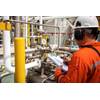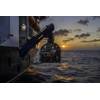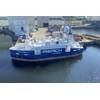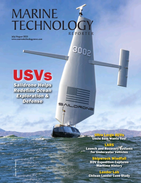Fugro recently completed two site investigation campaigns for Ferrovial Agroman and Laing O'Rourke, the consortium undertaking construction of the project’s central section for client, Tideway. Over a seven-month period, work included drilling, downhole geophysics and testing to depths of 80 metres to provide ground risk and engineering data along a 10-kilometre stretch of the river.
Efficiency in cycle-time and river transit in tidal waters was crucial in delivering information to suit the phasing of planning and design. To meet a programme that involved 55 bridge manoeuvres negotiating 12 of the Thames’ most famous, but also structurally diverse bridges, Fugro designed, manufactured and installed adaptations to its Skate 2D jack-up platform.
The conventional method when passing under bridges involves a support barge and crane to install, remove and transport the platform legs. Reconfiguring the deck to accommodate a crane enabled Fugro to carry out the handling and storage of platform legs on the vessel, eliminating the need for an additional barge. A full suite of geotechnical drilling, sampling and testing equipment, that could be mechanically folded, was also carried.
Fugro’s self-removing leg system, with the addition of the onboard storage cradle, is believed to be a first for a modular jack-up platform undertaking geotechnical work on the river. Matt Chappell, a specialist in nearshore site investigation at Fugro, said, “Our uniquely designed platform simplified logistical and health and safety management risks for the complex transits and bridge manoeuvres, improving efficiency and reducing supply chain risk. It also reduced the cost to the client by eliminating the need for a support barge together with associated standing time incurred from tidal delays.” Disruption to river traffic was also minimised.
Shawn Sismondi, senior geotechnical engineer for Ferrovial Agroman, said, “The Skate 2D proved well suited to dealing with London’s various challenges. As well as bridge transits, its ability to safely undertake ground investigation in close proximity to tunnels, river walls and heliports was extremely useful.”
One of the UK’s biggest civil engineering projects, the £4.2 billion Thames Tideway will incorporate 25 kilometres of tunnelling to update London’s ageing sewer system for modern needs.












 August 2025
August 2025



